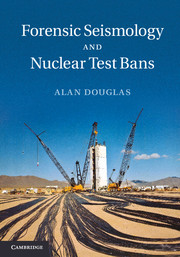Book contents
- Frontmatter
- Contents
- Preface
- Abbreviations and mathematical symbols
- Prologue
- 1 Seismology: ancient and modern
- 2 Statistical solutions to seismological problems
- 3 Seismograms as time series
- 4 Seismographs and seismograms
- 5 Seismometer arrays and processing methods
- 6 Seismogram interpretation and synthesis
- 7 Hypocentres and P travel times
- 8 Seismic magnitudes
- 9 Seismic source identification
- 10 Epilogue
- Appendix A P and S radiation from a double-couple source
- Appendix B Normal equations for analysis of variance
- Appendix C Some uses of the FFT
- Appendix D Anelastic attenuation
- Appendix E The relation of the transient and steady-state responses
- Appendix F Seismometer–galvanometer systems
- Appendix G SNI from summing array recordings
- Appendix H The equations for computing MP filters
- Appendix I Circular arrays
- Appendix J Geometrical spreading when S reflects as sP
- Appendix K The Fourier integral for a dispersed wave train
- Appendix L Tables of explosions and earthquakes
- Appendix M Album of body-wave seismograms
- Appendix N Exercises
- References
- Further reading
- Author index
- Index
2 - Statistical solutions to seismological problems
Published online by Cambridge University Press: 05 March 2013
- Frontmatter
- Contents
- Preface
- Abbreviations and mathematical symbols
- Prologue
- 1 Seismology: ancient and modern
- 2 Statistical solutions to seismological problems
- 3 Seismograms as time series
- 4 Seismographs and seismograms
- 5 Seismometer arrays and processing methods
- 6 Seismogram interpretation and synthesis
- 7 Hypocentres and P travel times
- 8 Seismic magnitudes
- 9 Seismic source identification
- 10 Epilogue
- Appendix A P and S radiation from a double-couple source
- Appendix B Normal equations for analysis of variance
- Appendix C Some uses of the FFT
- Appendix D Anelastic attenuation
- Appendix E The relation of the transient and steady-state responses
- Appendix F Seismometer–galvanometer systems
- Appendix G SNI from summing array recordings
- Appendix H The equations for computing MP filters
- Appendix I Circular arrays
- Appendix J Geometrical spreading when S reflects as sP
- Appendix K The Fourier integral for a dispersed wave train
- Appendix L Tables of explosions and earthquakes
- Appendix M Album of body-wave seismograms
- Appendix N Exercises
- References
- Further reading
- Author index
- Index
Summary
Statistics, one may hope, will improve gradually, and become good for something.
Thomas Carlyle, ChartismHow to be precise though vague.
M. J. Moroney, Facts from figuresIntroduction
The statistical analysis of reported arrival times of seismic body waves carried out by Jeffreys and Bullen to derive travel-time tables is a landmark in the development of seismology. This is evident from the longevity of the tables – first published in 1936 – it was only in the 1990s that a new set has been judged sufficiently superior to the J-B tables to warrant their replacement. Before the CTBT negotiations, seismic amplitudes had not been subject to the same rigorous analysis. Yet when the negotiations began almost all the discussion on explosion seismograms seems to have been on P amplitudes and station magnitudes. The magnitudes (principally recorded at local and regional distances) are scattered and how these should be combined to give a magnitude for an explosion was a matter of sometimes bitter debate.
As the number of nuclear tests of significant yield and hence the number of amplitude observations increased, it became clear that some stations tend to record above average amplitudes and others below average. As amplitudes and magnitudes, particularly their relationship to yield, was of such interest in the early negotiations, AWE Blacknest began to try to make sense of magnitude observations and look for systematic effects.
- Type
- Chapter
- Information
- Forensic Seismology and Nuclear Test Bans , pp. 46 - 71Publisher: Cambridge University PressPrint publication year: 2013



